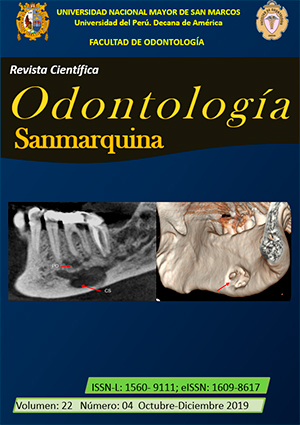Considerations in the orthodontic treatment of patients with special needs. Review of the literature
DOI:
https://doi.org/10.15381/os.v22i4.17047Keywords:
Dental care for disabled, Malocclusion, Orthodontics (source: MeSH NLM)Abstract
The American Academy of Pediatric Dentistry defines Special Health Care Needs as “any physical, developmental, mental, sensory, behavioral, cognitive, or emotional impairment condition or limitation that requires medical management, health care intervention, and/or the use of specialized services or programs”. Currently, patients with special health needs present a higher survival rate and higher life expectancies. In addition, they present a higher prevalence and severity of malocclusion that negatively impact their general health and quality of life. The growing concern of parents and professionals for the aesthetic and functional aspect, has led to an increase in the demand for orthodontic treatment, however, the health care access still remains limited. A review of the available literature was performed aiming at describing the considerations in the orthodontic treatment of special health care needs patients. It is concluded that the treatment should not be denied just for presenting a disability. Notwithstanding, it is crucial for the treatment success parents and/or caregivers commitment. The treatment should be planned in stages, being of great importance the care adaptation phase. The overall treatment time is similar to those patients without special needs, but still requires longer armchair time and the results obtained are usually lower. Orthodontic treatment can improve aesthetics and function in patients with disabilities, facilitating their social integration and positively impact in their quality of life.
Downloads
Downloads
Published
Issue
Section
License
Copyright (c) 2019 Noemí Leiva-Villagra, Francisca Ayala-Jiménez, Carolina Stange-Dempster, Vanessa Fuentes-Flores, Sebastián Véliz-Méndez

This work is licensed under a Creative Commons Attribution-NonCommercial-ShareAlike 4.0 International License.
AUTHORS RETAIN THEIR RIGHTS:
a. Authors retain their trade mark rights and patent, and also on any process or procedure described in the article.
b. Authors retain their right to share, copy, distribute, perform and publicly communicate their article (eg, to place their article in an institutional repository or publish it in a book), with an acknowledgment of its initial publication in the Odontología Sanmarquina.
c. Authors retain theirs right to make a subsequent publication of their work, to use the article or any part thereof (eg a compilation of his papers, lecture notes, thesis, or a book), always indicating the source of publication (the originator of the work, journal, volume, number and date).






